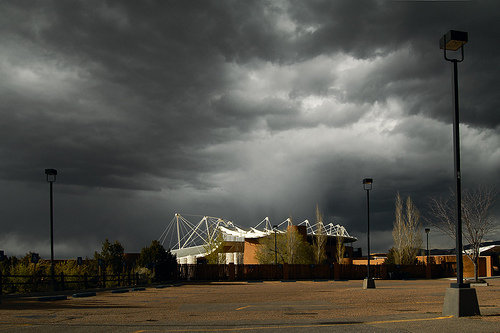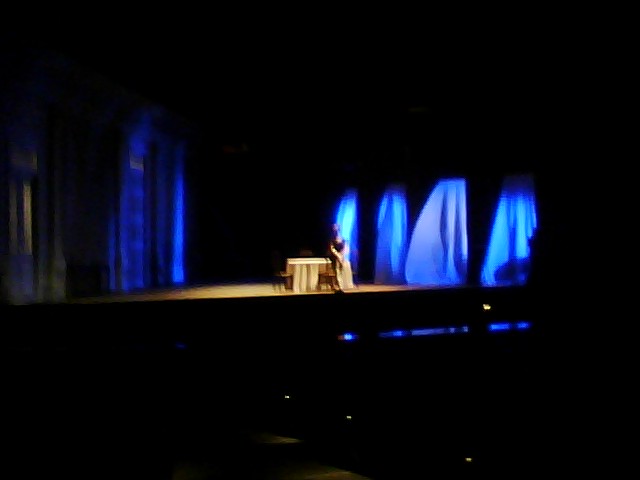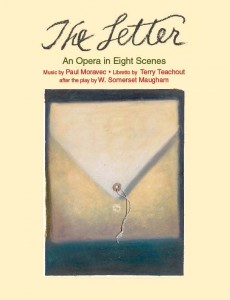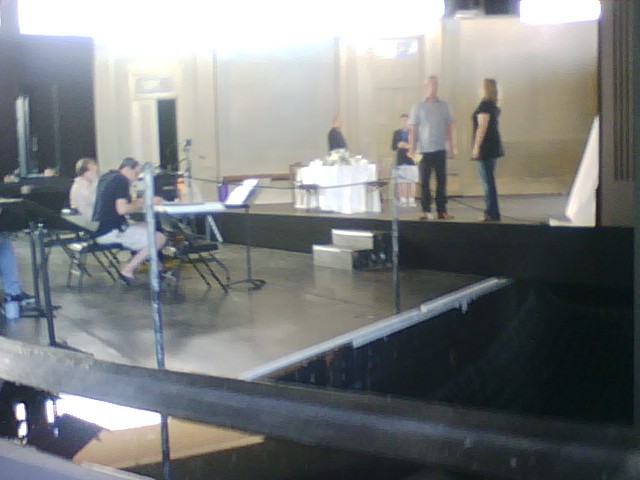 The first orchestral dress rehearsal of The Letter began in a rainstorm. Even after the rain stopped, there was fog throughout the area. That’s not an inappropriate effect for an opera noir, though I would have preferred lightning. Fortunately, the Santa Fe Opera‘s Crosby Theatre, while it’s an open-air house, is shielded more or less effectively from the weather, so the rehearsal started on time–immediately after sunset–and proceeded without incident.
The first orchestral dress rehearsal of The Letter began in a rainstorm. Even after the rain stopped, there was fog throughout the area. That’s not an inappropriate effect for an opera noir, though I would have preferred lightning. Fortunately, the Santa Fe Opera‘s Crosby Theatre, while it’s an open-air house, is shielded more or less effectively from the weather, so the rehearsal started on time–immediately after sunset–and proceeded without incident.
I don’t want to court the wrath of the theater gods, but I can’t deny what everyone seems to be saying this morning, which is that last night’s rehearsal went extraordinarily, even phenomenally well. All of Monday’s minor glitches cleared themselves up as if by magic, and everyone in the cast rose to the occasion and performed as though their lives depended on it. On Monday we got to see what the show looked like for the first time, and now we know how it will sound with all the design elements in place and fully functioning. Not to put too fine a point on it, but The Letter looks like a movie, sounds like an opera, and plays like a play. It is, in short, everything that Paul Moravec and I had hoped for it to be, and we’re thrilled beyond words.
No rehearsal tonight! Mrs. T has arrived, and the two of us are going to take the evening off and see Don Giovanni after Paul and I talk to an Associated Press reporter and give a presentation on The Letter in downtown Santa Fe. The final dress begins at nine o’clock sharp tomorrow night. I can’t wait….
Archives for July 2009
TT: Snapshot
The theatrical trailer for the 1940 film version of The Letter, directed by William Wyler and starring Bette Davis:
(This is the latest in a weekly series of arts-related videos that appear in this space each Wednesday.)
TT: Almanac
“You can do anything in this world if you are prepared to take the consequences.”
W. Somerset Maugham, The Circle
TT: The news in brief
 Monday’s dress rehearsal for The Letter went very, very well. This was the first time that we saw Tom Ford’s costumes on stage, as well as the first time that all of Duane Schuler’s lighting cues were run in sequence. The combination was…well, pretty overwhelming. The Letter really does look like a film noir, only in color and with a transfiguring touch of early-Forties glamour. Between them, Tom, Duane, and Hildegard Bechtler, our set designer, have pulled out all the stops: gleaming white suits, louvered windows, ceiling fans, muslin curtains that billow in the moonlight, dark shadows that criss-cross the stage.
Monday’s dress rehearsal for The Letter went very, very well. This was the first time that we saw Tom Ford’s costumes on stage, as well as the first time that all of Duane Schuler’s lighting cues were run in sequence. The combination was…well, pretty overwhelming. The Letter really does look like a film noir, only in color and with a transfiguring touch of early-Forties glamour. Between them, Tom, Duane, and Hildegard Bechtler, our set designer, have pulled out all the stops: gleaming white suits, louvered windows, ceiling fans, muslin curtains that billow in the moonlight, dark shadows that criss-cross the stage.
I doubt I’ll be tweeting today–I have a frenetic schedule throughout the day, followed by the first orchestral rehearsal in the evening–but I’ll try to let you know how things went when I get home late tonight. For the moment, though, all systems appear to be go, and then some.
TT: Almanac
“No one really knows anything much about a play until it meets its first audience; not its director, its actors, its producers, and least of all its author. The scenes he has counted on most strongly, his favorite bits of fine writing–the delicately balanced emotional or comedic thrusts, the witty, ironic summing up, the wry third-act curtain with its caustic stinging last line that adroitly illuminates the theme–these are the things that are most likely to go down the drain first, sometimes with an audible thud.”
Moss Hart, Act One
TT: All there is
 The Letter opens on Saturday, and I find it harder and harder to think or write about anything else. Among other distractions, I have two pieces due this week, a “Sightings” column for Saturday’s Wall Street Journal and an essay about Alan Ayckbourn for the September issue of Commentary. Needless to say, I’ll get them written–I don’t miss deadlines–but in a perfect world, I wouldn’t have anything to do but eat, sleep, and rehearse.
The Letter opens on Saturday, and I find it harder and harder to think or write about anything else. Among other distractions, I have two pieces due this week, a “Sightings” column for Saturday’s Wall Street Journal and an essay about Alan Ayckbourn for the September issue of Commentary. Needless to say, I’ll get them written–I don’t miss deadlines–but in a perfect world, I wouldn’t have anything to do but eat, sleep, and rehearse.
The Santa Fe Opera makes such single-minded concentration easy, for its headquarters is a campus-like complex of buildings located atop a seven-thousand-foot-high mesa north of town. Between rehearsing, eating in the cantina, and lounging by the company-only swimming pool, it’s perfectly possible to spend virtually all of your time in Santa Fe at the ranch (as we opera types call it). So far I’ve also managed to hang out with one old friend and one new one, buy a copy of the new Elmore Leonard novel at Garcia Street Books, and eat a green chile cheeseburger at Bert’s Burger Bowl, but otherwise I haven’t done much of anything since arriving in Santa Fe that wasn’t more or less directly related to The Letter. I haven’t even taken time off to visit the Georgia O’Keeffe Museum, which is quite an oversight on the part of an art-loving boulevardier.
Why am I so wrapped up in The Letter? My work on the opera, after all, is all but done. I’ve rewritten one line of the text and signed off on two cuts since arriving in Santa Fe last Sunday, but that’s been about it. The cast and production team don’t really need me, and I’ve mostly been trying not to get under their feet. Yet I went so far last night as to spend two hours watching a lighting rehearsal of The Letter, when I could have stayed home and read Road Dogs instead. (“I can’t believe you’re here,” said Duane Schuler, the lighting designer. “This is like watching grass grow.”)
 What is it, then, that keeps drawing me back to the ranch, and to the men and women who are bringing The Letter to life? Part of it is that they’re all very nice people–I’m a bit surprised by how straightforwardly companionable my colleagues are–but the biggest reason, I suspect, is that I find it both exciting and reassuring to be in the presence of the work of art to which Paul Moravec and I have devoted so much of the past three years of our lives. Right now I want nothing more than to hear and see The Letter as often as possible, not on my iBook or in my imagination but on the stage of the Santa Fe Opera. Only then does it become real.
What is it, then, that keeps drawing me back to the ranch, and to the men and women who are bringing The Letter to life? Part of it is that they’re all very nice people–I’m a bit surprised by how straightforwardly companionable my colleagues are–but the biggest reason, I suspect, is that I find it both exciting and reassuring to be in the presence of the work of art to which Paul Moravec and I have devoted so much of the past three years of our lives. Right now I want nothing more than to hear and see The Letter as often as possible, not on my iBook or in my imagination but on the stage of the Santa Fe Opera. Only then does it become real.
If The Letter were a painting, I could hang it on my wall and look at it as often as I liked, but an opera, like a play or a ballet, is nothing more than a set of instructions, an idea that must be brought to life through the act of performance. If music, as I have remarked on more than one occasion, is an art form whose meaning is radically ambiguous, then theater is an art form whose content is radically evanescent. The Santa Fe Opera will perform The Letter six times, and it’s entirely possible that it will never be seen again after that. Even if it should be taken up by other companies, it won’t be done in the same way that it’s being done here and now. Is it any wonder, then, that I want to hurl myself into this unrepeatable, irreplaceable experience–that I want, as actors say, to be as “present” as I can possibly be?
Henry James said it: we shall never be again as we were. That’s true of every moment of our lives. Of course they should all be infinitely precious, and of course they’re not–we toss them aside heedlessly, charging on to the next experience. For me, though, these particular moments are different. Yesterday I found myself thinking of these oft-quoted lines from the last scene of Our Town:
EMILY Do any human beings ever realize life while they live it?–every, every minute?
STAGE MANAGER No.
Pause.
The saints and poets, maybe–they do some.
I’m neither of those things, but I do know what’s happening to me this week, and I think I’m realizing as much of it as it’s possible for an ordinary human to grasp. I only wish it could go on and on and on.
TT: Almanac
“I remember years ago climbing up to the fly gallery of the Globe (now the Gielgud) Theatre in Shaftesbury Avenue. It was the final night of Ten Times Table. The set was due to be struck and a new set brought in and fitted up. This new set was also for a play of mine, Joking Apart. For about three days (and some nights) I watched as dozens of stagehands, painters, electricians, stage managers and prop makers swarmed across the stage, first dismantlng one set and then assembling the other. The director in me watched with fascination while somewhere inside, the writer was silently screaming: My God, what have I started?”
Alan Ayckbourn, The Crafty Art of Playmaking
SUBMITTED FOR YOUR APPROVAL
“While a fair number of playwrights and directors have written criticism on the side, very few drama critics have changed directions in midcareer and written for the stage, and fewer still have had any luck at it. I’m trying to beat those odds…”
